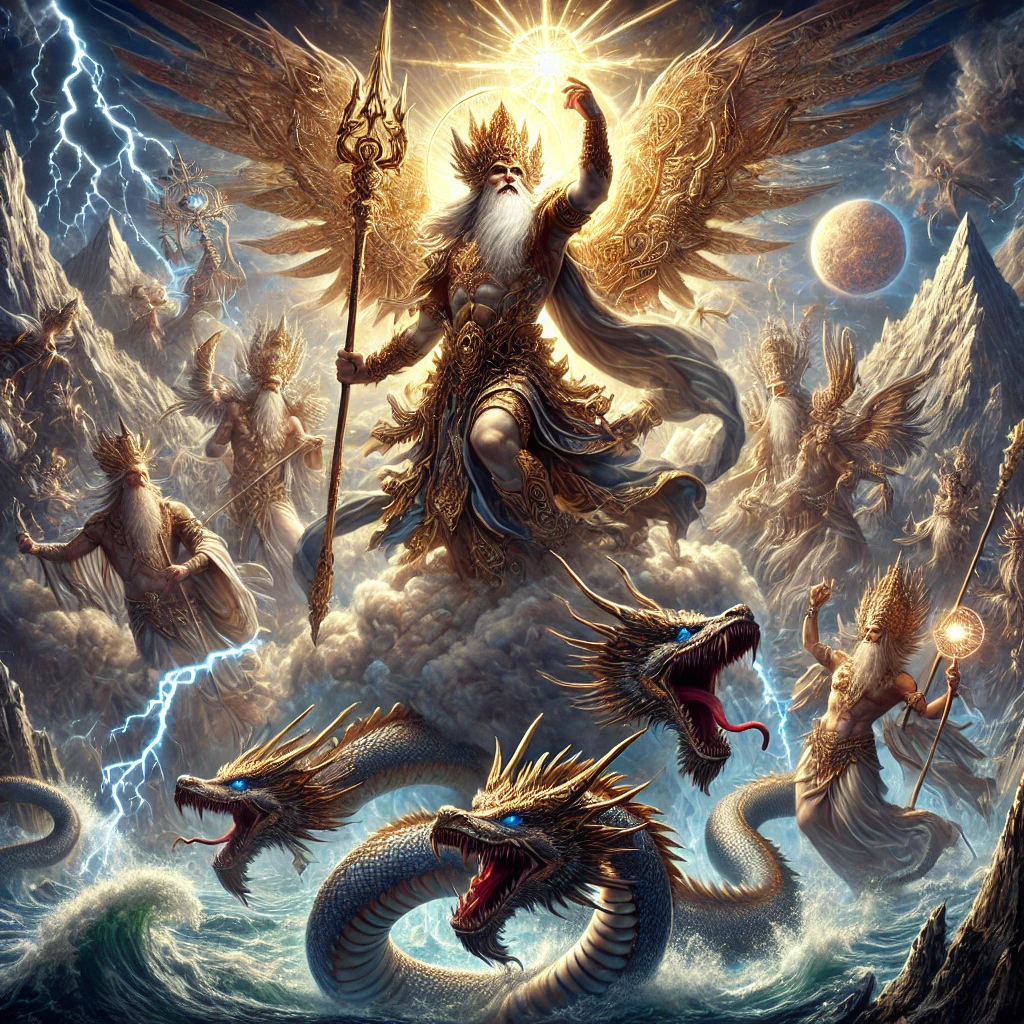Marduk standing triumphantly, exuding divine power, with the dragon Tiamat writhing furiously below amidst stormy waters.
How the World’s Oldest Tales Inspired the Humor and Adventure of The Funny Epic of Gilgamesh
When you think of ancient myths, solemn tales of gods, monsters, and morality lessons probably come to mind. And while Mesopotamian myths certainly had those elements, they were also wildly imaginative, strange, and occasionally amusing. These ancient stories have endured for millennia, continuing to spark inspiration—including my own retelling of The Funny Epic of Gilgamesh.
Let’s step into the world of Mesopotamian mythology and explore what makes these tales so timeless—and so much fun to reimagine.
The Epic of Gilgamesh: The Original Hero’s Journey
Written over 4,000 years ago, The Epic of Gilgamesh is the oldest recorded story in history. It follows the adventures of Gilgamesh, the boastful king of Uruk, as he embarks on a quest for immortality.
What Makes It Legendary?
- An Unlikely Friendship: At its heart, the story is about the friendship between Gilgamesh and Enkidu, a wild man introduced to civilization. Their bond shows that even the strongest heroes need a friend to ground them—and keep their egos in check.
- Battles with Beasts: From defeating the monstrous Humbaba in the Cedar Forest to slaying the Bull of Heaven, the epic brims with danger and excitement.
- A Search for Meaning: After Enkidu’s death, Gilgamesh grapples with the ultimate human question: How do we find meaning in life when death is inevitable? He doesn’t find eternal life, but he does find wisdom.
In my version, I kept the grandeur but added a playful twist. Instead of a solemn quest for immortality, picture Gilgamesh and Enkidu bickering about who has to carry the treasure or stumbling through encounters with talking trees.
Gods with Big Personalities
The gods of Mesopotamian myths were powerful, unpredictable, and, at times, hilariously petty. Their human-like flaws provided rich material for my retelling.
Key Players:
- Ishtar (Inanna): In my novel, Ishtar is Gilgamesh’s sister—a princess and adventurer. Her boldness and charm add a dynamic layer to the story, making her both a lovable ally and a formidable force.
- Shamash: The sun god and a surprisingly sensible figure who aids Gilgamesh and Enkidu.
- Enlil: A grumpy god who, at one point, wanted to wipe out humanity for being too noisy. (We’ve all been there.)
These gods’ over-the-top personalities inspired many of the comedic moments in my retelling, turning divine drama into something readers can laugh at.
Monsters and Mischief
Mesopotamian myths are filled with grand, awe-inspiring elements—the majestic Cedar Forest protected by Humbaba and the mighty Bull of Heaven whose roar could shake the ground. In my version, I replaced mythical beasts with ordinary things like towering trees and mischievous squirrels. Picture Gilgamesh and Enkidu bungling their way through these everyday encounters, turning what could have been terrifying moments into lighthearted, chaotic adventures.
Enduring Themes
What makes these ancient stories relevant even today? They tackle universal themes that resonate across time:
- Friendship: The bond between Gilgamesh and Enkidu highlights the importance of connection.
- Mortality: The quest for immortality reflects humanity’s timeless struggle to accept the inevitability of death.
- Hubris: Many myths, including this one, caution against arrogance—a lesson Gilgamesh learns the hard way.
These themes inspired me to blend depth with humor in my retelling, creating a story that entertains while encouraging readers to reflect on life’s big questions.
Finding Humor in the Myths
While Mesopotamian myths are often serious, they also contain moments that can be unintentionally funny. Imagine:
- The gods squabbling among themselves, exposing their human-like flaws.
- Gilgamesh bragging about his strength and heroic feats, only to be humbled by unexpected challenges.
- Enkidu, unfamiliar with city life, being introduced to bread and beer—an important but amusing cultural milestone.
The Inspiration Behind The Funny Epic of Gilgamesh
Reimagining these ancient tales for a young audience meant preserving the epic scale while amplifying the humor. Here’s how I approached it:
- Modernized Dialogue: I gave Gilgamesh a voice that sounds more like a confident young adult who thinks he knows everything.
- Comedic Adventures: Each adventure is filled with playful twists, featuring characters like Squawk, the mischievous parrot who proudly squawks at the most inconvenient moments, and Chatter, the spirited monkey who can’t resist leaping headfirst into every new escapade.
- Relatable Characters: Whether it’s Enkidu navigating the challenges of city life, Ishtar balancing her sweet, gracious nature with moments of bold defiance, or Ashur, whose calculating mind and quiet intrigue quietly influence every palace rumor and minor conflict, I aimed to give each character familiar, relatable traits—emotions, relationships, and dilemmas that mirror our own, bringing their ancient stories closer to home.
Why These Stories Still Matter
Beyond entertainment, Mesopotamian myths offer a glimpse into the hopes, fears, and values of one of the world’s earliest civilizations. By reimagining these tales with humor and heart, I hope to inspire readers to see history not as a distant, dusty past, but as a vibrant source of adventure and wonder.
Did You Know?
The Epic of Gilgamesh was nearly lost to history. It wasn’t until the 19th century that archaeologists unearthed clay tablets in the ruins of Nineveh, bringing the story back to life after thousands of years.
Ready to Join the Adventure?
Dive into The Funny Epic of Gilgamesh: An Ancient Mesopotamia Tale Retold and discover how ancient myths can still make you laugh, think, and dream. Every great story begins with a little curiosity—and maybe a little of chaos!

